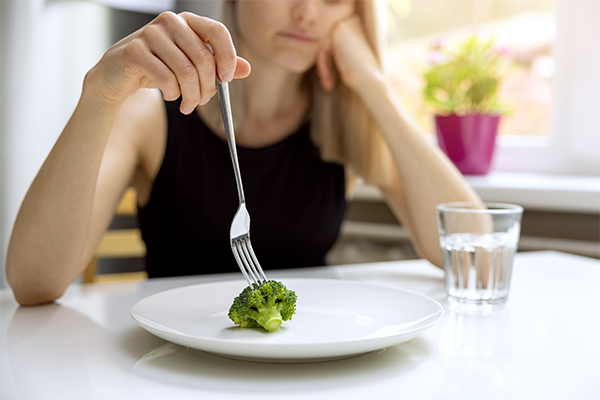Orthorexia: What Is It and What Can You Do About It?

Many of us reform our wellness routines in order to look and feel better — but it’s possible to take these efforts too far. For some, this can mean focusing on nutrition to the extent that it becomes harmful, a phenomenon some experts suggest should become an officially recognized eating disorder: orthorexia nervosa.
There are a number of causes and warning signs associated with orthorexia which are explored below, but if you think you may have a problem with disordered eating, it’s imperative to contact a medical or psychological professional for an evaluation.
What Is Orthorexia?
“Orthorexia is an unhealthy obsession with eating pure or clean foods… to the point where it negatively impacts an individual’s physical and mental wellbeing,” says Angela Ficken, LICSW, a Boston-based therapist.
“Unlike other eating disorders like anorexia or bulimia, orthorexia is primarily focused on the quality of food consumed rather than the quantity.”
Officially named in the late 1990s, it’s a condition that’s on the rise.
“Orthorexia is something I see fairly regularly in my practice, and I didn’t see it at all 10 years ago,” says Candice Seti, Ph.D., a clinical psychologist and certified personal trainer in San Diego.
Why Is Orthorexia on the Rise?
So what’s behind the surge in obsessive eating? Perhaps unsurprisingly, social media has a lot to answer for.
“The obesity epidemic has forced a focus on healthy lifestyles, and social media like Instagram inundates people with pictures of healthy eating, people with six-pack abs, and all sorts of memes telling people pain is gain,” Seti says.
“It sets people up to develop orthorexia. Whenever there is focus on anything, there will be the opportunity to take it too far.”
Although orthorexia nervosa is widely recognized, it’s not an officially diagnosable eating disorder. (Seti expects it will be soon.) Because of this, there are no official diagnostic criteria for orthorexia — however the condition does have several common traits.
If you suspect you or someone you know has orthorexic tendencies, it’s a good idea to check in with a medical professional.
Causes of Orthorexia
So what might cause someone to cross the line from healthy eating into orthorexia? Both internal and external factors can come into play. Some of those internal factors can include:
- Perfectionism. “Individuals with a tendency toward perfectionism might be drawn to strict dietary rules to gain a sense of control and accomplishment,” says Marissa Moore, MA, LPC, a Missouri-based licensed professional counselor.
- Anxiety. “The desire to maintain optimal health can escalate into anxiety about consuming anything perceived as unhealthy,” Moore adds.
- Low self-esteem.
- A need for identity. “People might adopt extreme diets to feel a sense of belonging within a certain health-conscious community,” Moore says.
People with a tendency toward obsessive thinking and behaviors also might fixate on the purity of their diet.
“Orthorexia has many features that parallel the symptoms of obsessive-compulsive disorder (OCD),” Seti says. “People are just consumed with thoughts of food, exercise, and planning.”
External factors can also motivate orthorexia. They can include:
- Media and social influences. “The glorification of clean eating and wellness trends on social media platforms can contribute to developing orthorexic tendencies,” Moore says.
- Cultural pressures. “Societal emphasis on thinness and health can lead individuals to pursue unrealistic dietary goals,” she says.
- Misinformation. You don’t have to be a credentialed nutrition expert to dispense advice on social media. A lot of what goes viral isn’t supported by science and can even be dangerous.
Warning Signs of Orthorexia
According to Staci Gulbin, MS, MEd, RDN, a registered dietitian nutritionist in Denver, the warning signs of orthorexia can include:
- Looking obsessively at nutrition labels before eating
- Labeling foods as “good” or “bad”
- Increasingly cutting certain foods or entire food groups out of your diet or viewing certain foods with fear
- Avoiding social situations involving food
- Becoming obsessed with what others are eating
- Not eating if “safe” foods aren’t available
- Spending more time online researching diets and “clean” eating, or on influencer sites that demonize foods (they may use language like “sugar is toxic” and “seed oils are poison”)
- Increasingly talking about eating habits in conversations with others
Of course, many of us do these things sometimes. It doesn’t mean you “have” orthorexia — which, remember, isn’t yet an official clinical diagnosis.
What Does an Orthorexic Diet Look Like?
“An orthorexic diet may cut out multiple food groups, be very limited to “safe” foods, and be very restricting,” Gulbin says. “Often orthorexic diets cut out anything that contains sugar, anything packaged, or anything eaten out in restaurants aside from ‘whole’ foods.”
The condition can look different from person to person. “Sometimes it can start with cutting out sugars, then slowly cutting out desserts, and then cutting out breads, pastas, and other starch carbohydrates altogether,” says Suren Chiu, RDN, LDN, CPT, a registered dietitian nutritionist and certified personal trainer in Chicago.
“For others, it can be limiting fats to a certain amount on the label, significantly limiting what the person can eat. It’s not uncommon for this to be paired with exercising, in a way that can also be obsessive.”
Risks of Orthorexia
Orthorexia is different from prioritizing good nutrition. “This lifestyle can deprive the orthorexic person of essential nutrients needed for optimal health,” Gulbin says.
Cutting out a large variety of foods can lead to a number of consequences, according to Gulbin:
- Heightened risk for nutrient deficiencies and malnutrition
- Strained personal relationships
- Mental and emotional health issues
- Diminished overall quality of life
Not to mention the burden imposed by orthorexic eating. “Counting every calorie and macro and reading every nutrition and ingredient label can become exhausting and debilitating,” Gulbin says.
What to Do About Orthorexia
If you or someone you know is exhibiting orthorexic traits, consult your healthcare provider or a mental-health professional.
“I always encourage people to seek professional help sooner rather than later,” Seti says.
Treatment of orthorexia primarily focuses on breaking the all-or-nothing mentality, while building self-esteem and facing fears.
“Catching it and intervening early is definitely the most effective route before any of these new, unhealthy behaviors get rooted. If you find yourself obsessing about food to the point where your life or your social relationships are impaired, you should seek help,” Seti advises.



